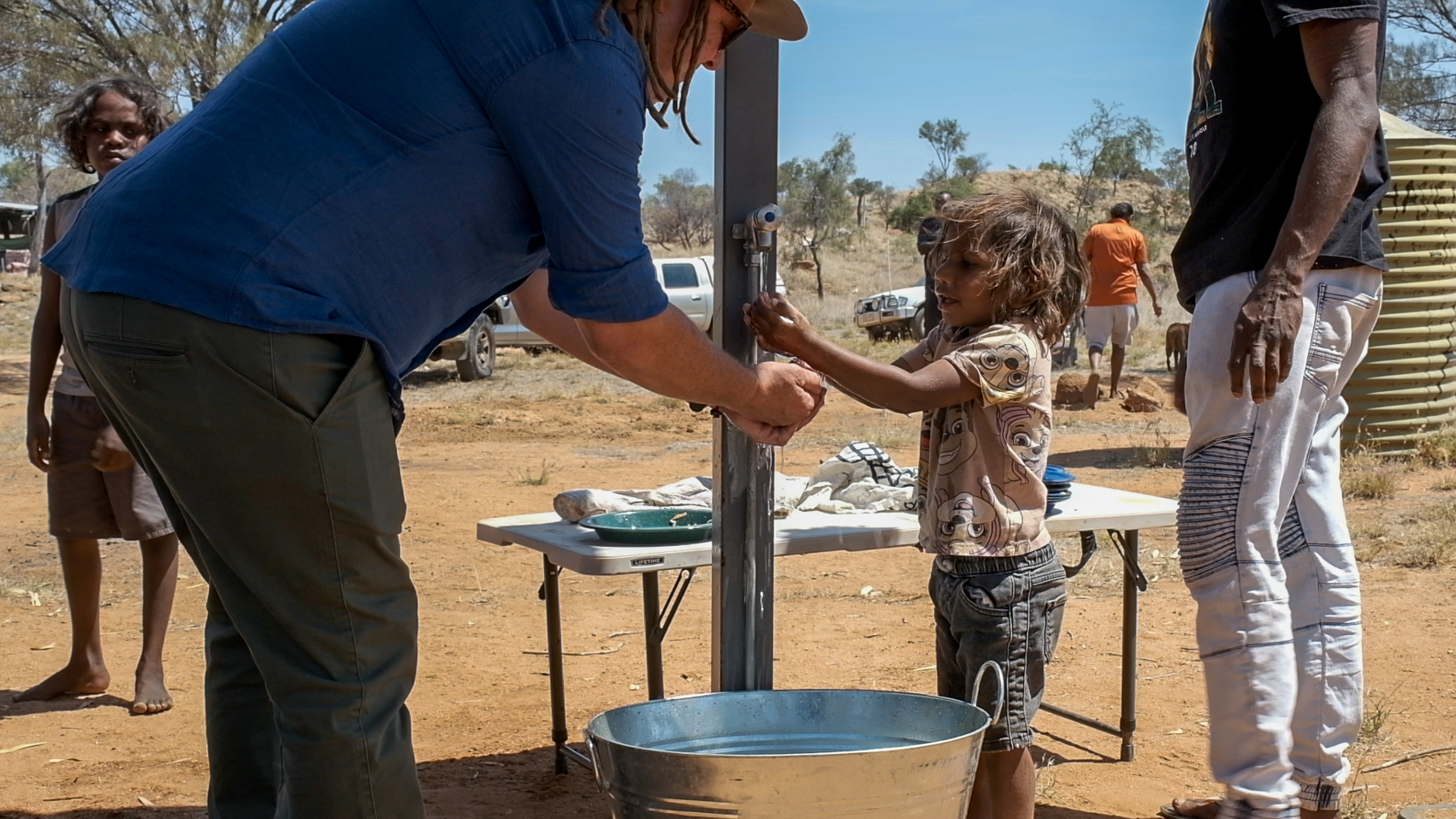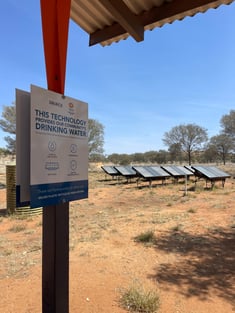Innovative tech set to shift the dial on remote access to safe drinking water

There are a myriad of challenges on the road to achieving global access to safe water, but one innovative water technology company is determined to solve the issue of remote drinking water for good.
SOURCE hydropanels produce high quality potable water using only two inputs: sunlight and air. Renewable energy is produced via solar PV, which powers fans that pull water vapour from the air. A process inside the panel turns the vapour into pure, liquid water, which is then mineralised within the unit for optimal taste, and kept safe in an internal storage tank.
While water production varies depending on the conditions at each site, the hydropanels have been optimised to operate within a broad range of weather conditions, and can produce water in low to medium sun, and with real humidity levels as low as 10%. The units operate independently of electrical or piping infrastructure.
Now established in over 50 countries, SOURCE Australia has been collaborating with Indigenous communities across Australia to secure reliable, clean drinking water in regional and remote locations.
For National Water Week (16-22 October), SOURCE Australia has partnered with the Australian Water Association to help raise funds for the supply and installation of SOURCE hydropanels at schools in remote communities that lack adequate supply of safe drinking water.
SOURCE Director of Market Development APAC, Alex Polson, said the company’s mission is to perfect water for every person, in every place.
“People that live in remote and regional areas deserve the same level of drinking water access and quality as those that live in cities,” he said.
“The UN estimates that there are 2 billion people who don’t have access to safe drinking water at home. And the Australian National University has released research that shows we have more that 400 communities here in Australia that lack reliable and safe drinking water."
“Our technology is a value-add in the places that struggle with the drinking water component of water delivery.”
Polson said the funds raised during National Water Week will help establish a secure supply of drinking water for a remote school, but that there are hundreds more schools, right across Australia, that are not connected to mains infrastructure.
“In Queensland, there are 250 schools that are not connected to mains piping infrastructure, relying upon plastic bottles or trucked water. The same story is replicated across the country in New South Wales, Western Australia and Northern Territory. In some cases the true figure is completely unknown,” he said.
“The Federal Government has earmarked $150 million for First Nations drinking water infrastructure. For a fraction of that cost, we could be using innovative drinking-water first solutions in remote communities, rather than larger, more time and capital-intensive solutions like laying pipes and building energy-intensive treatment facilities that have a high failure rate."
“If we use that funding efficiently, drinking water can be solved quickly, providing thousands of kids and communities with reliable drinking water.”
Overcoming remote provision challenges
Polson said the hydropanels have been designed to help eliminate many of the hurdles involved in achieving reliable and safe remote water provision: the panels offer decentralised access to a drought-proof water supply, manage taste and odour issues effectively, and require minimal maintenance.
“The hydropanels don’t need electricity or existing infrastructure to produce drinking water. They are a very practical solution that can be rolled out anywhere – from the desert to the tropics, from Alice Springs to Cape York or the Kimberleys,” he said.
“Each hydropanel is simply put on the ground or mounted on the roof. The solution is also infinitely scalable, just like traditional solar panels. If you need more water, you can just add more panels.”
The mineralisation process is also very important, Polson said, as the drinking water needs to be great quality and the community's first choice.
“The process of making the water means we end up with very pure, distilled water. We then remineralise it using calcium and magnesium, which ensures it tastes good, and is the correct pH for drinking water,” he said.
“Usually people don't live in places where there is absolutely no water. But the issue really is drinking water. That’s the real problem. And if taste and odour are an issue, a lot of communities will buy expensive bottled water instead, or sugary drinks. There is also a challenge in some areas with drinking water contamination, including elevated levels of nitrates, and even instances of E. coli."
“Non-potable water is fine for toilets or gardens, but when it comes to drinking water, it really needs to be top quality.”

Each panel is fitted with a wireless transmitter, allowing the SOURCE Network Operations Center to monitor hydropanels and help resolve issues remotely, Polson said.
Perhaps one of the most impressive benefits of the hydropanels is that they provide a drought-proof supply of water, all year long, and require no extraction of surface or groundwater.
“It’s an entirely new water supply, in that it is not drawn from ground or surface water bodies. This is important within a variety of contexts. It’s drought-proof,” he said.
“But it’s also important for Indigenous communities, too. Extracting from the Great Artesian Basin, or from important rivers and creeks, is often not culturally appropriate, or sustainable. We can collect water from the air without touching the local environment.”
Water on Country
Polson said SOURCE Australia collaborates with local communities with drinking water challenges, and are guided by the community to install the panels where the water is needed.
“The local communities work closely with us at every stage from planning, install, ongoing care and education. We seek to train community members to understand the importance of the systems and clean drinking water. As an example, after we installed 1,250 hydropanels on homes in western NSW, we trained members from the Indigenous land councils to become local leaders and subcontractors,” he said.
“We recently launched a hydropanel site with an NGO called Children’s Ground, located in Irrkerlantye (White Gate). The community is a 15-minute drive from the centre of Alice Springs."
“The families that live in that homeland community either had to have water delivered by truck or walk into Alice Springs to buy bottled water. We have installed enough panels in that community to provide a reliable source of drinking water to enable locals to live on Country, rather than having them rely on plastic bottles."
“We are launching this initiative with the Traditional Owners, who are assisting us with advocating to government to install similar systems in the thousands of homeland communities that exist within the Northern Territory, South Australia and Western Australia that are not connected to grids and struggle with contamination challenges.”
While global access to safe and reliable drinking water is not yet a reality, Polson said it’s important that Australia raises the bar when it comes to ensuring everyone has access.
“People talk about communities abroad needing to walk every day to fetch water and don’t realise that this is actually happening in Australia,” he said.
“We are going to continue to aim to perfect water for every person in every place. Working closely with community leaders and officials in Australia and the Pacific to improve drinking water access is where we are maintaining our focus.”
Find out more about the SOURCE/AWA National Water Week fundraiser here.

